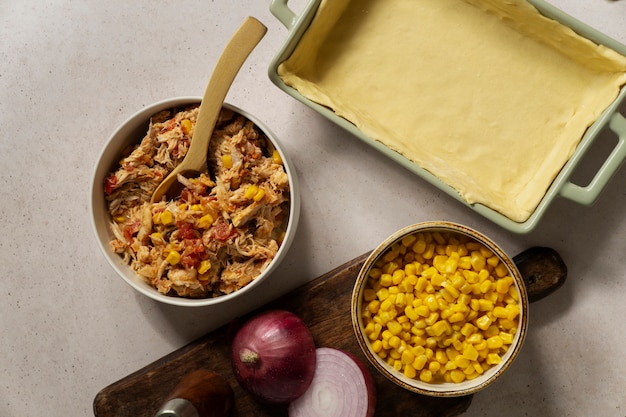Adobo. Just the word conjures up images of simmering, garlicky goodness, and the tantalising aroma that fills the air as it cooks. For many Filipinos, adobo isn’t just a dish, it’s a cultural touchstone, a comforting hug on a plate, a reminder of home. But for those venturing into the world of Filipino cuisine for the first time, adobo can seem a bit mysterious. So, let's delve into the heart of this iconic dish, from its humble origins to its endless variations, and uncover the secrets to making the perfect adobo.
My journey with adobo began in my childhood, visiting my Auntie in the Philippines. The kitchen was a whirlwind of activity, filled with the joyous chatter of family and the symphony of sizzling garlic, tangy vinegar, and rich soy sauce that made up the adobo. That’s when I knew, this wasn’t just another dish, it was something special.
Whether you’re a seasoned Filipino food aficionado or a curious beginner, this guide will take you on a journey through the world of adobo. We'll explore its history, uncover the fascinating diversity of its variations, and unlock the secrets to crafting adobo that's truly unforgettable. We'll cover everything from essential ingredients and cooking techniques to troubleshooting common pitfalls, and even dive into adobo’s place as a cultural icon. So, grab your apron, get ready to learn, and let's embark on this delicious adventure together!
(Part 1) Understanding the Essence of Adobo

A culinary legacy
Adobo's origins are shrouded in the mists of time, but one thing is certain – it’s a culinary treasure that has been a cornerstone of Filipino cuisine for centuries. The name itself, “adobo,” comes from the Spanish word “adobar,” meaning “to marinade.” The Filipinos, with their long history as seafaring people, were undoubtedly resourceful in finding ways to preserve food. Adobo, with its tangy vinegar and salty soy sauce, was the perfect solution, allowing them to enjoy their bounty even on long journeys.
This dish embodies the essence of Filipino cuisine – resourcefulness, adaptability, and a celebration of bold, vibrant flavours. Over the years, adobo has blossomed into an incredible array of regional variations, each reflecting the unique culinary traditions of different parts of the Philippines. The choice of vinegar, the addition of spices, or even the method of cooking – these are the nuances that make each regional adobo a distinct culinary experience.
Key Ingredients for a Classic Adobo
The magic of adobo lies in its simplicity. The classic adobo is a harmonious blend of just a few key ingredients:
- Meat: While pork and chicken are the most common, adobo can be made with a variety of meats, including beef, seafood, and even vegetables. The classic combination, however, is often a mix of pork belly and chicken legs, offering a delightful balance of rich flavour and tender texture.
- Vinegar: The tangy bite of vinegar is what defines adobo. Whether it's the sharp tang of cane vinegar or the mellow sweetness of coconut vinegar, it plays a crucial role in balancing the savoury notes and acting as a natural preservative.
- Soy Sauce: This essential ingredient adds depth and umami, creating that irresistible savoury flavour that makes adobo so addictive.
- Garlic: The pungent aroma and flavour of garlic are an integral part of the adobo experience. Don't be shy, let that garlic shine!
- Peppercorns: Adding a touch of warmth and subtle spice, peppercorns round out the flavour profile, creating a balanced and satisfying taste.
- Bay Leaves: The earthy, slightly bitter notes of bay leaves add a layer of complexity to the overall flavour, creating an unforgettable aroma.
These are the basic ingredients that lay the foundation for a classic adobo. But, as with all great recipes, the beauty of adobo lies in its adaptability. Feel free to experiment, adding a touch of ginger, a sprinkle of chilli flakes, or a handful of fresh herbs to create your own unique twist.
(Part 2) Unveiling the Variations of Adobo

Adobo is a culinary canvas, ready to be painted with different flavours and techniques. Each region of the Philippines has its own unique take on this beloved dish, resulting in a fascinating array of variations. Here are a few of the most popular adobo styles:
1. Adobong Manok (Chicken Adobo)
The most common type of adobo, Adobong Manok features tender chicken legs or thighs, simmered in the classic adobo marinade until they’re fall-off-the-bone tender. It's a delightful dish that's best enjoyed with a generous scoop of rice and a side of fresh tomatoes or a green salad.
2. Adobong Baboy (Pork Adobo)
Pork belly, with its rich, fatty flavour, is the star of this show! The adobo marinade beautifully complements the richness of the pork belly, resulting in a dish that is both indulgent and satisfying. Pork adobo is often cooked until the fat renders, creating a luscious, flavourful sauce.
3. Adobong Pusit (Squid Adobo)
Seafood lovers will adore Adobong Pusit! The squid is marinated in the adobo sauce and then cooked until it’s tender and slightly chewy. The result is a dish that's both delicious and exciting, often served with rice and a side of vegetables.
4. Adobong Patis (Fish Sauce Adobo)
For those seeking a deeper, more complex flavour, Adobong Patis is a must-try. This variation uses fish sauce instead of soy sauce, adding an extra layer of umami that elevates the overall taste. It's especially popular in coastal regions of the Philippines, where fish sauce is a staple ingredient.
5. Adobo sa Gata (Adobo in Coconut Milk)
Adobo sa Gata is a truly indulgent dish, featuring chicken or pork cooked in a rich coconut milk sauce, infused with the classic adobo flavours. The creamy coconut milk adds a luxurious touch, creating a dish that's both comforting and flavourful.
6. Adobo sa Puti (White Adobo)
This variation is a unique twist on the traditional adobo. Chicken or pork is cooked in a light sauce with lots of garlic, resulting in a white-coloured sauce that stands out from the typical dark brown adobo. The flavour is equally distinct, offering a subtle and delicate flavour profile.
(Part 3) Mastering the Art of Adobo

Now, let’s dive into the heart of creating a truly unforgettable adobo. With these tips and techniques, you’ll be well on your way to mastering this culinary art:
1. Choosing the Right Ingredients
The foundation of any great adobo lies in the quality of its ingredients. While you can use any cut of meat, I personally recommend pork belly or chicken legs. The fat in pork belly adds a rich, mouthwatering flavour, while chicken legs provide a nice balance of meat and skin. Remember, when it comes to adobo, using quality ingredients will result in a significantly better dish.
The choice of vinegar is a matter of personal preference. Cane vinegar offers a sharper, more pronounced tang, while coconut vinegar has a sweeter, more mellow flavour. Experiment and find the vinegar that best suits your taste.
Garlic is absolutely crucial. Use fresh garlic, and don't be afraid to go bold – the more garlic, the better!
2. The Magic of Marinating
Marinating is key to unlocking the full potential of your adobo. It allows the flavours of the marinade to deeply penetrate the meat, ensuring it’s tender and juicy. I recommend marinating the meat for at least 30 minutes, but ideally, you should let it marinate overnight for the best results.
3. The Art of Slow Simmering
Adobo is a dish that demands patience. Slow, gentle simmering is essential to achieve the desired tenderness and allow the flavours to meld perfectly. Simmer the meat in the adobo sauce until it’s fall-off-the-bone tender. This process ensures that the meat is cooked through and the flavours are deeply infused.
You can simmer adobo on the stovetop or in the oven. I personally prefer using a heavy-bottomed pot on the stovetop, as it provides even heat distribution.
4. The Finishing Touches
The final stage is where you truly elevate your adobo. Once the meat is tender, you can thicken the sauce by adding a tablespoon or two of cornstarch slurry (cornstarch mixed with water). This creates a luscious, velvety sauce that clings perfectly to the meat.
Some people prefer adding a bit of sugar or brown sugar to balance out the tanginess of the vinegar. You can also add some extra bay leaves at this stage for a more pronounced aroma.
(Part 4) Adobo Pitfalls: Avoiding Common Mistakes
We’ve all been there – the excitement of making adobo, the meticulous following of the recipe, and then…something goes wrong. Don’t worry, it happens to the best of us! Let’s tackle some common adobo pitfalls and how to avoid them:
1. Overcrowding the Pot
This is a frequent error, particularly when making a large batch of adobo. Overcrowding prevents the heat from circulating evenly, leading to uneven cooking and potentially soggy adobo. Ensure there’s ample space between the pieces of meat to allow for proper heat distribution.
2. Not Simmering Long Enough
Remember, patience is key! You need to simmer the meat long enough for it to become tender and for the flavours to develop fully. Don’t rush the process, or you’ll end up with tough, chewy meat. It’s always better to err on the side of over-simmering.
3. Using Too Much Vinegar
Vinegar is a powerful ingredient, and it’s easy to go overboard. Too much vinegar can result in an overly sour taste and can hinder the meat from becoming tender. Start with a moderate amount of vinegar, taste as you go, and adjust accordingly.
(Part 5) Serving Adobo: A Culinary Symphony
You’ve put in the effort, you’ve cooked the adobo to perfection, and now it’s time to enjoy the fruits of your labour! Here’s how to present your adobo in a way that will tantalise your taste buds:
1. The Classic Pairing: Rice
No adobo is complete without a heaping serving of steamed rice. The fluffy rice acts as the perfect vehicle for the rich adobo sauce, creating a delicious harmony of flavours and textures.
2. A Touch of Freshness: side dishes
Adding a complementary side dish can elevate your adobo to new heights. I love serving adobo with a fresh salad, some sauteed vegetables, or a simple side of steamed green beans. The contrasting textures and flavours beautifully complement the rich adobo sauce.
3. The Ultimate Presentation
For serving adobo, I prefer a rustic, homey approach. A simple platter or a large serving bowl filled with the tender meat and glistening sauce is all you need. Add a few sprigs of fresh cilantro, a sprinkle of toasted sesame seeds, or a few chopped green onions for a touch of colour and flavour.
(Part 6) Beyond the Basics: Adobo Innovations
While we’ve explored the classic adobo recipes, remember, adobo is a canvas for culinary creativity. Here are a few ideas to inspire your own adobo adventures:
1. Spiced Adobo
Elevate your adobo with a touch of heat and depth. Experiment with adding spices like star anise, cinnamon sticks, or even a touch of chilli flakes. These spices will add a beautiful complexity and warmth to your adobo.
2. Adobo with a Twist
Don't be afraid to try new things! Add a touch of citrus zest, a splash of white wine, or a handful of fresh herbs to create a unique and delicious adobo that's entirely your own.
3. Adobo-Inspired Dishes
The flavours of adobo can be used to create a variety of delicious dishes. Think adobo pasta, adobo pizza, or even adobo tacos. Get creative and explore the endless possibilities!
(Part 7) Adobo as a Cultural Icon
Adobo is more than just a delicious meal. It's a cultural symbol that embodies the spirit of the Filipino people. It's a dish that brings people together, evoking memories of family gatherings, festive celebrations, and the simple joys of good food.
When I think of adobo, I think of home, of comfort, and of the strong bonds that tie Filipinos together. It's a dish that transcends generations, a culinary heritage that continues to be passed down through the years.
(Part 8) Adobo for Every Occasion
From simple weeknight dinners to elaborate family feasts, adobo is a versatile dish that can be enjoyed on any occasion. It's a crowd-pleaser that's sure to impress, and it's a dish that you can feel good about serving, knowing it comes with a rich cultural history.
Whether you're a seasoned chef or a beginner in the kitchen, I encourage you to give adobo a try. It’s a delicious and rewarding dish that’s sure to become a favourite in your household.
FAQs
1. Can I freeze adobo?
Absolutely! Adobo freezes beautifully. Simply transfer the cooked adobo to an airtight container and freeze for up to 3 months. Thaw overnight in the refrigerator before reheating.
2. What type of vinegar should I use for adobo?
The type of vinegar you use depends on your preference. Cane vinegar gives a sharper, more tangy flavour, while coconut vinegar has a sweeter and more mellow flavour. Experiment and find the vinegar that best suits your taste.
3. How can I make adobo less salty?
If you find your adobo is too salty, you can add a bit of sugar or brown sugar to balance out the saltiness. You can also add a bit more vinegar to dilute the saltiness.
4. Can I add other ingredients to my adobo?
Absolutely! Adobo is a versatile dish, and you can add other ingredients to give it your own unique flavour. Some popular additions include onions, ginger, chillies, or even a touch of citrus zest.
5. Can I make adobo in the slow cooker?
Yes, you can! slow cooking is a great way to make tender and flavorful adobo. Simply combine all the ingredients in a slow cooker and cook on low for 6-8 hours, or on high for 3-4 hours.
Now, go forth, my culinary adventurers, and embrace the magic of adobo. From the simple joy of a classic recipe to the thrill of your own personal creations, this dish has something to offer every food lover. Enjoy!
Everyone is watching

Corn on the Cob: The Ultimate Guide to Perfectly Cooked Ears
Healthy MealsAh, corn on the cob. Just the name evokes images of sunny days, barbecues, and that sweet, juicy flavour that ...

Scallops: The Ultimate Guide to Perfect Cooking
Healthy MealsAh, scallops. Those delicate, sweet, and utterly delicious morsels of the sea. They hold a special place in my...

Spaghetti Squash: The Ultimate Guide to Cooking and Serving
Healthy MealsRemember that time you saw spaghetti squash at the supermarket, looking all bumpy and strange, and thought, "W...

Salmon Cooking Times: Perfect Guide for Every Recipe
Healthy MealsLet me tell you, cooking salmon is an art form. It's all about getting that perfect balance: juicy and tender,...

Ham Cooking Time: How Long to Bake, Smoke, or Boil a Delicious Ham
Healthy MealsAh, ham. It's a classic, isn't it? A real crowd-pleaser, especially around holidays. And when done right, it'...
